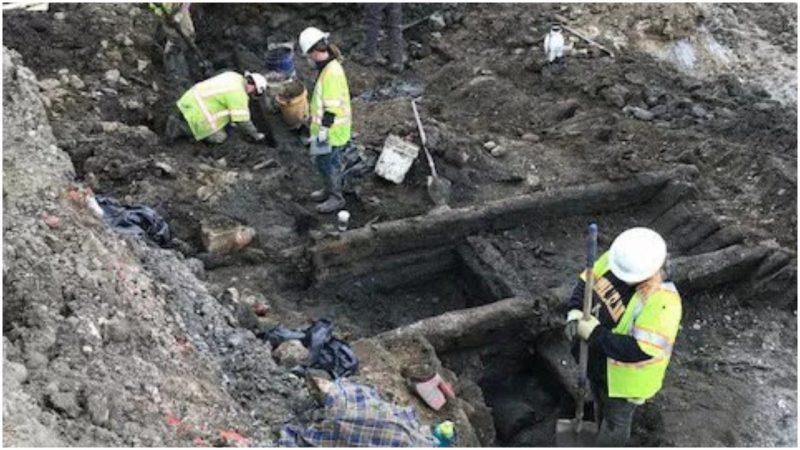Whether they’re revealed by storm damage or the shovels of a construction crew, artifacts from past centuries are coming to light all over the place these days, from tombs to precious coins to ships. But three ships underneath a single block? It seems like a bit much–unless you’re talking about Alexandria, Virginia. For this four centuries’ old city close to Washington, D.C., honoring history is part of everyday life, with walking tours snaking past the Federal-style townhouses and even a nightly ghost tour, sharing stories like the bride who stood too close to the fireplace.
The ships were discovered in March 2018 by contract archaeologists working with a developer on a townhouse and condominium project at Robinson Landing, which is along the Potomac River. Visible to the public, the largest is partly buried but looks to be about 25 feet wide and 46 feet long. The other two, much more difficult to see, are somewhat smaller.
All three ships are believed to have been built in the mid-to-late 1700s, and buried before 1798, according to the city website. The theory as to why the ships are there is they became worn out after a great deal of use and scuttled there, to help build up the new land required for Alexandria’s expanding port.
“The wet wood was last dry when local resident George Washington had just retired from the presidency to nearby Mount Vernon, in a time before the invention of indoor plumbing, gas lighting or the steam locomotive,” reported The Washington Post.
Work is now underway to preserve the city’s latest archaeological finds.
“The combination of Revolutionary War-era ships, early building foundations, and thousands of other artifacts makes Robinson Landing one of the most archaeologically significant sites in Virginia,” said Eleanor Breen, acting City Archaeologist. “The discoveries at this site have gained international attention, and the city is working with EYA to identify and preserve these important pieces of Alexandria’s history.”
Alexandria was part of a 6,000-acre land grant from Sir William Berkeley, Governor of Virginia, awarded to Robert Howson, an English ship captain, on October 21, 1669. The grant was made in the name of King Charles II in recognition of Captain Howson’s bringing 120 people to live in Virginia. It became an important port in the mid-1700s, especially valuable to the Southern aristocrats owning large tobacco plantations. It was also an important destination for the British army during the French and Indian War.
“In 1763, another land sale was held greatly increasing the size of the community,” according to Alexandria.gov. “Twenty years later, more new land was created by filling in part of the Potomac shoreline, allowing merchants to build wharves which reached ocean-going vessels in the river’s deep water channel.”
Over the next century, Alexandria was, tragically, a key slave auction site. When the Civil War broke out, Virginia seceded from the Union, but Federal troops arrived in Alexandria to take possession of the city so close to Washington D.C. It became a logistical supply center for the Federal army. Wounded soldiers were sent there, and some of the largest buildings were transformed into hospitals.
One of the most interesting events in Alexandria’s history took place right after the Federal troops arrived in 1861. President Abraham Lincoln had for weeks been infuriated by the site of an 8- by 14-foot Confederate flag flying on the top of an Alexandria inn, the Marshall House. Lincoln could see it from the White House with a spyglass.
It so happened that one of Lincoln’s personal friends, Col. Elmer E. Ellsworth, who had once worked in Lincoln’s Illinois law office, was in charge of the Federals who took over Alexandria. He was commander of the 11th New York Volunteers, also known as the First Fire Zouaves. Once in Alexandria, Ellsworth proceeded to Marshall House to have the Confederate flag lowered. He personally took down the flag, but on the way out of the inn, he was shot by Marshall House’s owner, James Jackson, a supporter of slavery. Both Ellsworth and Jackson died in the confrontation.
Ellsworth’s body was taken to the White House, and then to New York City, where the crowds of mourners reached the thousands. “Remember Ellsworth” became a Union rallying cry.
Alexandria thus holds the distinction of being the site of the first death of a Union soldier of the Civil War. The Marshall House is now the site of another hotel on Alexandria’s main street, with photographs in rooms and in the lobby of both Union and Confederate soldiers.
Nancy Bilyeau, the U.S. editor of The Vintage News, has written a trilogy of novels set in the court of Henry VIII: ‘The Crown,’ ‘The Chalice,’ and ‘The Tapestry.’ The books are for sale in the U.S., the U.K., and seven other countries. For more information, go to www.nancybilyeau.com.
